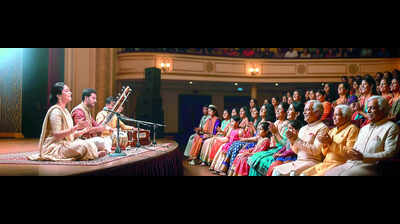ARTICLE AD BOX

Most Indian music lovers can puff out “Smoke on the Water” or breeze through “Deewana Hua Baadal”. For a while, hummers across the country had made a Tamil question — “Why this Kolaveri Di” — as persistent as Hamlet’s “To be, or not to be” inquiry.
But a raga crushes this karaoke gusto. Novices — present company included — stoke their own diffidence by assuming that their ignorance of classical music theory revokes their right to enjoy sound. India’s longest classical music conference, Saptak, will soon beckon stalwart performers to Ahmedabad. The run-up to the festival is a propitious time to reassure novices. Most people in this demographic are aware that Hamsadhvani is often a concert’s inaugural raga.
In a Carnatic setting, Hamsadhvani usually delivers “Vatapi Ganapatim”.The Bruce Springsteen test Even the non-initiates will sense that Hamsadhvani’s opening notes emerge in a slack glow, like sunrays performing yoga stretches at dawn. Then the rays dance at Zumba pace, one sparkle magnifying another. The finale’s beam undulates like a devotee prostrating in gratitude. These instinctual reactions, however, seem inadequate to music lovers.
They desire at least a smidgen of knowledge of raga physics, especially the classical science that governs the escape velocities of rocketing notes.
Their despondency is out of tune with the musical education of non-experts. Lessons dawn on us over decades. When “Born in the USA” was released in India in the 1980s, many of us interpreted it as a disco ditty. Eventually, Google tut-tutted at us and broke to us the thesis of “Born in the USA”: Springsteen fulminates against the hostilities that military veterans face after returning home from duty. Nevertheless, we enjoyed the song. As with any genre of music — Beethoven’s symphonies or Indian classical compositions — experts can parse the technicalities of “Born in the USA”. Not all of us know melody, major-key chords, or rhythm. Nevertheless, we enjoyed the song. To make Indian classical music enjoyable for neophyte listeners, TOI sought insights from Vidushis Ranjani & Gayatri, Shubha Mudgal, and Viraj Amar.MUTE ESOTERICISM: SHUBHA MUDGALShubha Mudgal, a commanding presence in the Hindustani pantheon, said, “Perhaps first-timers could consider starting out with a receptive mind and heart, devoid of any preconceptions about the classical system being too esoteric, complex, or not for the uninitiated.” She said, “Perhaps they could also start by just experiencing classical music, by being observers who could possibly note the rapport between the artistes on stage and the rapport the artistes share with the audience.”

Mudgal advised first-timers to observe “the skill and brilliance of each member of the ensemble on stage, and note which of the sounds, if any, speak to them”. TOI suggested that people could benefit from annotations such as those presented by Arden Shakespeare editions, where every line is explained. “I think a guide is almost always helpful, but perhaps more so in the case of written or printed textual material,” Mudgal said. “While reading a book, one can refer to footnotes, annotations, even line-by-line meanings. But during a live concert, this might be distracting or intrusive for other listeners.” She indicated a way out. “For recorded music, annotations and guided listening sessions would definitely be most helpful,” she said. Mudgal then posited an institution-level initiative: “Organizers could consider holding interactive sessions prior to a concert that could make classical music more accessible for first-time listeners.” She said it is “also necessary to provide factual information, instead of only anecdotes and myths or unverified claims of the superiority of the classical system over all other musical systems in the world, or even its close association with divinity and mythology”.Mudgal spoke of some resources that could provide continuing education. “Anuja Kamat has several videos on her YouTube channel, which new listeners may find helpful,” Mudgal said. “Saptak podcasts, particularly by artistes like Srijan Deshpande, are also extremely well thought out.” Many non-initiates find it useful to relate to classical music when it is revealed that ragas afford the base for numerous hit film songs.
But the frisson of recognition, Mudgal said, may provide only a sparse thrill. “A bandish or composition based on classical ragas cannot prepare a new listener for the truly magical world of spontaneous elaboration or vistaar, which is the hallmark of classical music,” Mudgal said.
She said she doesn’t want to completely reject any attempt to make classical music accessible. “But I do not think that the Bollywood route is an effective one,” she said. However, she said, “One of the possible ways would be to curate special performances with carefully chosen artistes, repertoire, and perhaps even an interdisciplinary element by bringing in storytelling, elements from theatre, and costumes.”RANJANI & GAYATRI: RAGA-BASED FILM SONGS CAN BE FIRST STEP Ranjani & Gayatri, luminaries of the Carnatic world, pointed to a leaf from the Western classical book that Indian music impresarios could borrow. “When we performed a couple of weeks ago in Europe, we created something called the ‘concert notes’,” Ranjani said.
Western classical music programmes have such notes, she said, which present audiences with information about the featured pieces. “We prepared concert notes for our programmes, in which we gave a background on our expositions,” Gayatri said. “The information included the meanings of the compositions and brief profiles of the composers. We explained what ‘Manodharma’ meant.”

If readers look up Manodharma on YouTube, they will find legendary singers running notes like a bullet train, while improvising the routes without ever applying the brakes.
The train, however, cannot leave the assiduously laid tracks of musical grammar. Ranjani said, “The notes also summarized the importance of Ragam Tanam Pallavi.” Ragam in Carnatic music is the same as raga in the Hindustani tradition — the melodic structure. Tanam comprises the chant-like utterances of notes, cohering into an extempore, rapturous prayer. Pallavi is the elaboration of a composition’s opening line. “We distributed the concert notes to all attendees. Efforts like these require a lot of work from artistes as well as the organizers,” Gayatri said. “We have to ideate and curate what we are going to sing.” It is absolutely all right for listeners to use film hits as a means to start their raga-identification journey, Ranjani said. “When listeners are at the nascent stage of familiarizing themselves with ragas, film compositions may be the best resource for doing so,” she said. Ranjani said legions of purists appreciate ‘Alaipayuthey’ (from the eponymous 2000 Mani Ratnam hit) for drawing inspiration from Raga Kanada. Then Ranjani sang the opening line. On her WhatsApp audio note, her rendition was a 3-second bravura demo of classical purity amplified by IT and popular culture. “Film music composers such as Naushad, Ilaiyaraaja, S D Burman, R D Burman, and A R Rahman have used raga-based compositions to bridge the gap between lay listeners and classical music,” Gayatri said. In conclusion, Ranjani proposed the creation of museums. “These museums can offer audio-visual glimpses into Indian classical music,” she said. “Perhaps the displays and installations can focus on the chief aspects of classical music. The museums can be the key centres of engagement with our traditions.”SUR BEFORE GRAMMAR: VIRAJ AMARViraj Amar, a Banaras Gharana notable from Ahmedabad, cautioned first-timers against listening to classical music through the crackle of technicalities. “Music is not to be understood, but experienced. It is ‘fine art’ and not craft,” Amar said. “Of course, if you understand the nuances and language, a different experience will be earned.”

She said, “To be able to enjoy classical music, you just have to flow along with the sur.” As for Bollywood crib sheets, Amar said, “I do not feel the need for reference or establishing a connection with a popular melody or a song. That can make it more relatable, but draw unnecessary comparisons.” She said, for aspiring rasikas, “the focus has to be on the story and not on the grammar”.
With these generous tips from the doyennes, you should prepare for Saptak without fearing musical grammar.
After all, you were content with singing Mick Jagger’s ‘I Can’t Get No Satisfaction’ without worrying about the double negative, weren’t you?

 6 hours ago
5
6 hours ago
5








 English (US) ·
English (US) ·